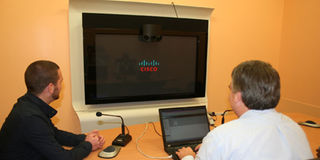Judiciary launches virtual courts

PAUL WAWERU | NATION
Mr Graham Jones of Cisco telepresence business unit (right) and Mark Higgins, a telecommunications engineer with the company, test the country’s first video link court at the Nairobi Law Courts, Wednesday.
What you need to know:
Basics on video conferencing
- Each participant has a video camera, microphone, and speakers mounted on his or her computer.
- As participants speak to one another, their voices are carried over the network and delivered to the other’s speakers.
- Whatever images appear in front of the video camera appear in a window on the other participant’s monitor.
Judges talk into cameras and lawyers bow to screens as technology arrives at local courts following the launch of video link on Wednesday.
Court of Appeal judges Alnashir Visram, Philip Waki and Moijo ole Keiwua go into history as the first ones to hold a court session sitting in Nairobi and the rest of the participants in Mombasa.
The first litigant to enjoy the benefit of technology is Yasmin Abdulkarim, trading as Ali Advocate, who sued Southern Credit Banking Corporation Ltd. This case was heard by appeal judge Ole Keiwua.
Fibre optic technology
The first link was created between the Mombasa and Nairobi law courts, thanks to the advent of fibre optic technology.
Witnesses, suspects and lawyers in a case will now participate in court sessions from anywhere in the country without having to travel.
However, this can only happen once a witness, litigant or lawyer gives consent in writing that he or she is fine with having the case conducted via video.
Video conferencing is the conduct of discussions between two or more parties in different areas using computer networks that transmit audio and video information.
The second session of the virtual court will be conducted Thursday morning by Mr Justice Visram. It will be a case between Ms Aisha Bahi Ali Mohammed and Maritime Freight.
The lawyer representing Ms Mohammed is former High Court judge Andrew Hayanga.
Speaking to the Nation, Justice Visram said: “This is a great leap forward for the Judiciary.
“We can now begin to dispense justice more quickly and efficiently and bring it closer to the people.”
He added: “This is the most exciting milestone in our work. I am honoured to be among the first to conduct hearing of cases via video link.”
The Judiciary has lined up 56 cases to be heard via video link.
It has also finalised digitising registries at the Milimani Commercial Courts and is in the process of doing the same at the Nairobi Law Courts.
So far, cases filed at the Milimani High Court since 1999 have been all scanned and stored in digital form.
The Nation has also learnt that all the files at the criminal registry at the Nairobi Law Courts have been digitised and those at the Family Division are also undergoing the same process.
Through a digitised system, one can access court files at the click of a mouse.
This, according to High Court Registrar Lydia Achode, is aimed at curbing incidents of court files getting lost.




